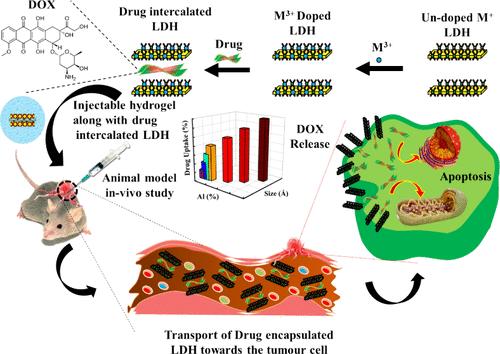Doxorubicin-Intercalated Li–Al-Based LDHs as Potential Drug Delivery Nanovehicle with pH-Responsive Therapeutic Cargo for Tumor Treatment
IF 5.4
2区 医学
Q2 MATERIALS SCIENCE, BIOMATERIALS
引用次数: 0
Abstract
Clinical oncology is currently experiencing a technology bottleneck due to the expeditious evolution of therapy defiance in tumors. Although drugs used in chemotherapy work for a sort of cell death with potential clinical application, the effectiveness of chemotherapy-inducing drugs is subject to several endogenous conditions when used alone, necessitating the urgent need for controlled mechanisms. A tumor-targeted drug delivery therapy using Li–Al (M+/M3+)-based layered double hydroxide (LDHs) family has been proposed with the general chemical formula [M+1–x M3+x (OH)]2x+[(Am–)2x/m. n(H2O)]2x−, which is fully biodegradable and works in connection with the therapeutic interaction between LDH nanocarriers and anticancerous doxorubicin (DOX). Compositional variation of Li and Al in LDHs has been used as a nanoplatform, which provides a functional balance between circulation lifetime, drug loading capacity, encapsulation efficiency, and tumor-specific uptake to act as self-regulatory therapeutic cargo to be released intracellularly. First-principle analyses based on DFT have been employed to investigate the interaction of bonding and electronic structure of LDH with DOX and assess its capability and potential for a superior drug carrier. Following the internalization into cancer cells, nanoformulations are carried to the nucleus via lysosomes, and the mechanistic pathways have been revealed. Additionally, in vitro along with in vivo therapeutic assessments on melanoma-bearing mice show a dimensional effect of nanoformulation for better biocompatibility and excellent synergetic anticancer activity. Further, the severe toxic consequences associated with traditional chemotherapy have been eradicated by using injectable hydrogel placed just beneath the tumor site, and regulated release of the drug has been confirmed through protein expression applying various markers. However, Li–Al-based LDH nanocarriers open up new design options for multifunctional nanomedicine, which has intriguing potential for use in cancer treatment through sustained drug delivery.

多柔比星钙化锂铝基 LDHs 作为具有 pH 响应性治疗载荷的潜在药物输送纳米载体用于肿瘤治疗
由于肿瘤中抗药性的快速发展,临床肿瘤学目前正经历着技术瓶颈。尽管化疗药物可导致某种细胞死亡,具有潜在的临床应用价值,但化疗诱导药物的有效性在单独使用时会受到多种内源性条件的影响,因此迫切需要可控机制。有人提出了一种利用锂-铝(M+/M3+)为基础的层状双氢氧化物(LDHs)家族的肿瘤靶向给药疗法,其化学通式为[M+1-x M3+x (OH)]2x+[(Am-)2x/m. n(H2O)]2x-,该疗法可完全生物降解,与 LDH 纳米载体和抗癌药物多柔比星(DOX)之间的治疗相互作用有关。LDHs 中 Li 和 Al 的组成变化被用作一种纳米平台,它在循环寿命、药物负载能力、封装效率和肿瘤特异性摄取之间实现了功能平衡,可作为自我调节的治疗货物在细胞内释放。我们采用基于 DFT 的第一性原理分析,研究了 LDH 与 DOX 的键合作用和电子结构,并评估了其作为优质药物载体的能力和潜力。纳米制剂内化到癌细胞后,通过溶酶体被带到细胞核,其机理途径已被揭示。此外,对黑色素瘤小鼠进行的体外和体内治疗评估表明,纳米制剂的尺寸效应具有更好的生物相容性和出色的协同抗癌活性。此外,通过将可注射水凝胶置于肿瘤部位下方,消除了传统化疗的严重毒性后果,并通过应用各种标记物的蛋白质表达证实了药物的调节释放。然而,基于锂-铝的 LDH 纳米载体为多功能纳米药物开辟了新的设计选择,它在通过持续给药治疗癌症方面具有引人入胜的潜力。
本文章由计算机程序翻译,如有差异,请以英文原文为准。
求助全文
约1分钟内获得全文
求助全文
来源期刊

ACS Biomaterials Science & Engineering
Materials Science-Biomaterials
CiteScore
10.30
自引率
3.40%
发文量
413
期刊介绍:
ACS Biomaterials Science & Engineering is the leading journal in the field of biomaterials, serving as an international forum for publishing cutting-edge research and innovative ideas on a broad range of topics:
Applications and Health – implantable tissues and devices, prosthesis, health risks, toxicology
Bio-interactions and Bio-compatibility – material-biology interactions, chemical/morphological/structural communication, mechanobiology, signaling and biological responses, immuno-engineering, calcification, coatings, corrosion and degradation of biomaterials and devices, biophysical regulation of cell functions
Characterization, Synthesis, and Modification – new biomaterials, bioinspired and biomimetic approaches to biomaterials, exploiting structural hierarchy and architectural control, combinatorial strategies for biomaterials discovery, genetic biomaterials design, synthetic biology, new composite systems, bionics, polymer synthesis
Controlled Release and Delivery Systems – biomaterial-based drug and gene delivery, bio-responsive delivery of regulatory molecules, pharmaceutical engineering
Healthcare Advances – clinical translation, regulatory issues, patient safety, emerging trends
Imaging and Diagnostics – imaging agents and probes, theranostics, biosensors, monitoring
Manufacturing and Technology – 3D printing, inks, organ-on-a-chip, bioreactor/perfusion systems, microdevices, BioMEMS, optics and electronics interfaces with biomaterials, systems integration
Modeling and Informatics Tools – scaling methods to guide biomaterial design, predictive algorithms for structure-function, biomechanics, integrating bioinformatics with biomaterials discovery, metabolomics in the context of biomaterials
Tissue Engineering and Regenerative Medicine – basic and applied studies, cell therapies, scaffolds, vascularization, bioartificial organs, transplantation and functionality, cellular agriculture
 求助内容:
求助内容: 应助结果提醒方式:
应助结果提醒方式:


